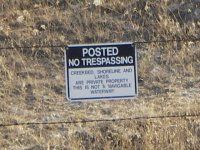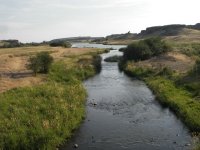Don Shearer
Active member
Hi,
I am hopeful that someone can direct me to some good and valid information on stream access law. More to the point what the stream access law is here in Washington State. If you look at the following pictures you can probably figure out why I am questioning the law. I have driven by this spot for about 10 years and I keep telling myself there is plenty of land to hunt in my state and I don’t have to hunt every inch of it, BUT the sign in the picture just annoys me, much like a small rock does when it gets into your hunting boot. Sometimes those rocks that fall into my boots are so small they don’t hurt but they are kind of just always on my mind and start to wear on my conscious until I have to take my boots off and get rid of the dam rock just so I can quit thinking about it. Well this sign has become like the little rock in my boot. I guess it isn’t so much that I cannot hunt the piece of water, but that if it is within my rights to hunt the piece of land that I am being kept out by an annoying sign then I cannot deal with that.
[inline imgp3391.jpg]
[inline imgp3390.jpg]
There have been a handful of times that I have had people try to run me off of public land. I know this piece isn’t public but if the use of the water is public it amounts to the same thing. Right?
Any advice on where to look for information?
I did find this in the RCW code:
“RCW 91.08.020
Accessible lands defined.
Lands shall be deemed accessible to such waterway when by reason of their nearness to the same their value will be materially increased by the construction or deepening or widening of such waterway.”
Well that really clears things up.
My best,
Don Shearer


I am hopeful that someone can direct me to some good and valid information on stream access law. More to the point what the stream access law is here in Washington State. If you look at the following pictures you can probably figure out why I am questioning the law. I have driven by this spot for about 10 years and I keep telling myself there is plenty of land to hunt in my state and I don’t have to hunt every inch of it, BUT the sign in the picture just annoys me, much like a small rock does when it gets into your hunting boot. Sometimes those rocks that fall into my boots are so small they don’t hurt but they are kind of just always on my mind and start to wear on my conscious until I have to take my boots off and get rid of the dam rock just so I can quit thinking about it. Well this sign has become like the little rock in my boot. I guess it isn’t so much that I cannot hunt the piece of water, but that if it is within my rights to hunt the piece of land that I am being kept out by an annoying sign then I cannot deal with that.
[inline imgp3391.jpg]
[inline imgp3390.jpg]
There have been a handful of times that I have had people try to run me off of public land. I know this piece isn’t public but if the use of the water is public it amounts to the same thing. Right?
Any advice on where to look for information?
I did find this in the RCW code:
“RCW 91.08.020
Accessible lands defined.
Lands shall be deemed accessible to such waterway when by reason of their nearness to the same their value will be materially increased by the construction or deepening or widening of such waterway.”
Well that really clears things up.
My best,
Don Shearer



